All about sketchbook

Many creative people, not just professional artists, have sketchbooks. This notebook, filled with notes and sketches, allows not only to record important moments as a keepsake, but also to develop imagination and train skills.


What is it and what is it for?
The word sketchbook is translated from English as "a book for sketches." From this we can conclude that a sketchbook is a notebook or notebook, in which thoughts, ideas, impressions and memories are recorded in the format of drawings and notes. The peculiarity of the sketchbook is that its spreads are always just white, without rulers or squares. Such blank pages are referred to as non-lined pages. A sketchbook differs from a regular notebook not only in content, but also in the paper used.
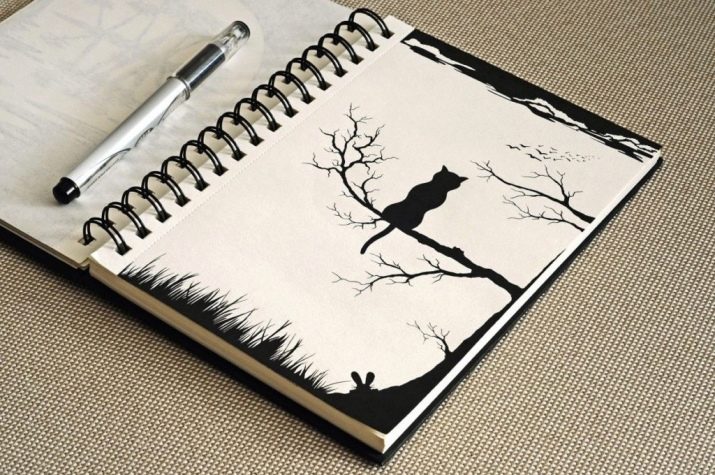
For a notebook, as a rule, thin sheets of paper are used in a ruler or box. In the case of a sketchbook, paper can be absolutely any, from the thinnest and almost transparent rice to watercolor, the density of which ranges from 300 to 600 grams. Quite often, pages for drawing with markers look the same as the "space" for pencil sketches, but the content is still different.


Basically, if you start drawing in a simple notebook, it will also begin to act as a sketchbook.
Typically, this creative notebook is compact and therefore easy to carry with you at all times. There are no special requirements for maintaining a sketchbook. On the first page, it is customary to write a table of contents or designate "introductory data".

You can also leave it blank. On clean spreads in one or several techniques, sketches, sketches or full-fledged works with numerous details are created.
What happens?
A review of notebooks for creativity allows us to conclude that today there are a huge number of them, and each person will be able to choose something to their liking. For example, you can choose between white and black notebooks.



By appointment
Professional sketchbooks are created for specific tasks, or rather, specific techniques. For example, you can buy "space" for graphics and writing, watercolors, markers and felt-tip pens, acrylic or pastels and pastel pencils. Marker drawings require thick sheets, and pencil drawings require a smooth surface. For watercolors, thick, but rather loose, weakly glued paper is intended, capable of absorbing moisture. They also release universal albums in which you can work with any materials.

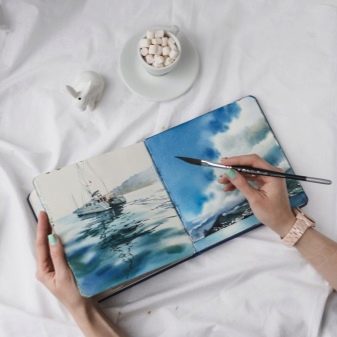
Of course, there can be creative notepads and targeted ones: targeting Polaroid photographs, architectural sketches, travel experiences, botanical observations. Artbooks require a consistent style or theme, and are dedicated to a specific person, event, or subject. In cookbooks, recipe entries are complemented by images of dishes in different styles. The design of a smashbook requires the use of additional items: tickets, photographs, receipts, clippings and tags.
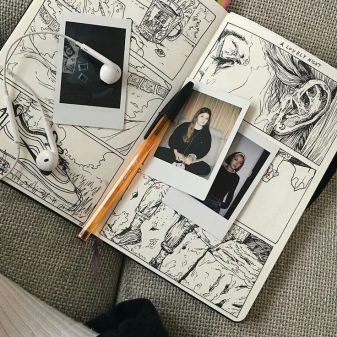

Size and shape
The sketchbook has two basic shapes: square and rectangular. In terms of size, the choice is usually made between a large A4 notebook, an A5 book and an A6 mini notebook.


Fastening
Most sketchbooks have soft binding or stitched pages, but ring or spring models are also available.


Cover
The cover of the album can be absolutely any externally. Some artists prefer monochromatic laconic products, while others choose something bright and colorful, for example, notebooks with avocados, unicorns or stylish illustrations. However, spiral notebooks and tablets require a hard back cover, and book notebooks require both hard and stable covers. The softbook stands apart - a notebook with a soft cover made of leather, linen, cotton and similar materials.


Review of the best
Let's take a closer look at some of the options.
- Royal Talens Art Creation is versatile and suitable for use with pencils, charcoal, markers, pastels and a regular pen. It can be used quite successfully for regular recordings as well. Quality sheets with a density of 140 grams per square meter prevent oil and gel ink from seeping. The product in A4 format in a cover of different shades is equipped with an elastic band and a tab.

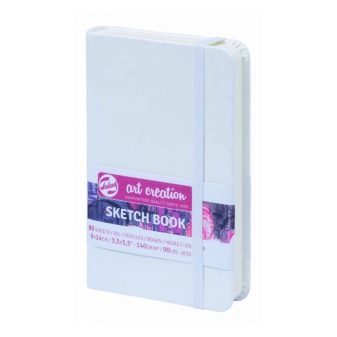
- Leuchtturm1917 Medium is usually chosen for markers and pencil sketches. The density of beige paper is 80 grams per square meter. A5 format sketchbook is available in different variations, including dotted, squared and ruled sheets. Ease of use is ensured by a pocket, a couple of bookmarks and a set of stickers for personalization.


- BRAUBERG Art Classic Fabriano looks simple but stylish. 70 grams per square meter paper is suitable for pastels, crayons and acrylics. On the one hand, the sheets have a roughness, and on the other - absolute smoothness, provided by impregnation with a special composition. A4 hard cover notebook allows you to create on the fly. A plus is the ability to choose between 2 paper colors: white and ivory.

- Fabriano Schizzi on a spiral is a typical sketchbook for working with soft materials. Micro-perforated sheets have a density of 90 grams per square meter and an ivory shade. This notebook is produced in A2, A3 and A4 formats.


- Falafel books BlackPaper is characterized by the presence of black sheets with a density of about 160 grams per square meter. The binding on a wide spiral, made of thick cardboard, retains its shape and allows drawing on the fly.You can work in this A5 sketchbook with pens, colored pencils or acrylic paint.

- Malevich Fashion issued in A4 format. Hardcover notebook with elastic band opens 180 degrees for easy sheet removal. White paper is treated with a special polymer impregnation, which absorbs ink and saves material consumption.


- Canson One Art Book is filled with sheets of 100 grams per square meter. A miniature A5 notebook is hidden in a black cover. The hard cover provides ease of use. His paper is extra blanc, that is, white to blue.

- Crouter City has a dense cover that can be used as a background for painting. A double loop with a metal spiral is responsible for the ease of turning the sheets. A4 notebook with 100 grams per square meter pages is suitable for drawing with pens, pencils, charcoal, crayons and markers.

- Moleskine Large is a versatile album with a great reputation. The sheets are made of acid-free paper with a density of 70 grams per square meter. Expandable pocket, tab and elastic closure are nice advantages. The notebook can be produced in A6, A5 and A4 formats.
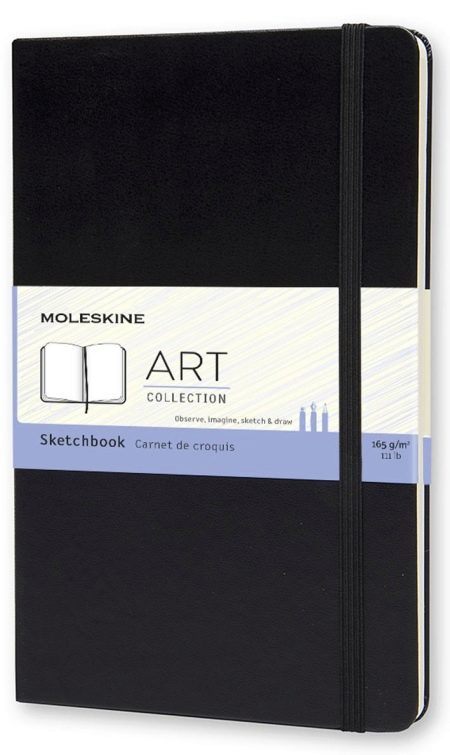
- Letraset A4 notebook there are 80 sheets with a density of 60 grams per square meter. The paper is white and very smooth, perfect for a marker. Molotow is an A4 album with 32 grayish sheets, has a density of 120 grams per square meter. Sketch Park has similar parameters on the spiral: A4 format, 120 grams per square meter, 40 sheets.



How to choose an album for sketching?
There are a number of important factors to consider when choosing an album for both the professional artist and the hobbyist.
- For example, an A4 notebook is rather thick and heavy, which is rather inconvenient to carry with you at all times. Moreover, very few people completely sketch out such an extensive notebook. The A5 format, on the contrary, is considered smallish, but it is convenient to transport it, plus, having unfolded, you can get the same A4 if necessary.

- For permanent use, the spiral mount is optimal. In this case, the paper is held tightly, without scattering, and the pages easily turn over in any direction.
It is also possible to tear out the leaf if necessary.


- A sketchbook for a professional must have a rigid backing. The optimal number of sheets is 48 pieces. The paper does not have to be white at all - options are possible with yellowish, brownish, gray or any other tinted paper. A dense surface will allow you to work with markers, and a thin and harsh surface will allow you to draw with a pencil. In general, the density of sheets ranges from 70 to 300 grams per square meter.

- Sheets can be smooth or covered with patterns. Textured albums are definitely not suitable for calligraphy, and in other cases, experimentation is quite possible. Work with watercolors takes place on cold or hot pressed paper. In the first case, the images get a sharper texture, and in the second, detailed images are obtained.
In terms of looks, most sketchbooks come in a versatile design, making them suitable for both girls and boys.

How to lead?
Getting started with sketchbooks can be a challenge, even for a professional designer, as the fear of a blank sheet is present in many. To overcome it, it is recommended that you start with something simple: copy someone's drawing, decorate the first page with initials, or simply fill the space with chaotic scribbles.
In the future, the maintenance of the sketchbook can be carried out as you like, but it will be correct to create sketches not from time to time, but constantly. It is not necessary to complete each work to the end: one day it may be a sketch of a bush or an unusual house, and on the other - a part of an illustration transferred from a magazine.
It makes sense to write explanatory notes or date alongside the sketches.

You should definitely save the completed sketchbook. First, it provides an opportunity to assess your own progress. Secondly, some ideas in the future can be embodied in more serious work. Finally, the best sketches can be used to decorate interiors or as gift cards.









